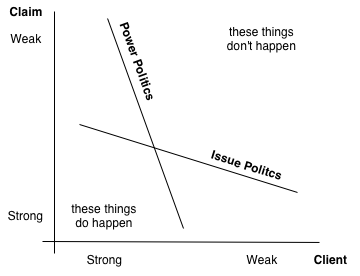I like the idea of “object shift” or “change of venue.” The idea is that if you loosing the argument in one forum you shift the discussion into a different one. For example you don’t want them to build a gas station on the corner and you can’t get the zoning board to stop it, then you might shift to trying to get the historical commission involved, and if that doesn’t work you shift to folks responsible for guarding the local water table.
Here’s a nice list of venues with that differ in time constant.
- Geology, Climate
- Nature, Ecology, Evolution
- Culture
- Governance
- Infrastructure
- Markets, Weather(?)
- Firms
- Fads, Storms
One of the fascinating aspects of the identity puzzle is how discussions skitter across so many of these. Different participants in the discussion relate to each of these in different ways. For example Visa’s strength is at the Firms and Markets layer. The standards bodies tend to emphasis the Market/Infrastructure layers. We are starting to see some fascinating work, via brain scans for example, of how trust runs deep in the human brain. What I love best about that work is how some of it shows that economics students brains are just plain different.
Take Stefan’s First Design Principle
FIRST DESIGN PRINCIPLE: The technical architecture of an identity system should minimize the changes it causes to the legacy trust landscape among all system participants.
It’s an appeal to the fad/firm/market levels to do no harm to the existing infrastrurure, governance, and culture. It’s an appeal to the sacred nature of the institutions that have long time constants.
Or consider Kim’s summing up at the tail of his reaction to my attempt to draw attention to the PR and agency function of “user at the center” rhetoric.
We should just make sure our technologies give individuals and organizations freedom of choice, and nurture an ecology of alternatives. Then people can “vote with their feet (fingers?)”.
What venue is that argument being made in?
Kim’s making an argument at the market/firm level. Nothing wrong with that; the short time constant institutions on that list are vital beasts. But, I’d rather that it was framed without grabbing words that are nearly sacred from other venues. The ecology mentioned isn’t the slow changing deeply wired human nature of trust, it’s the ecology of the firms in the jungle of the marketplace. The freedom is the freedom of consumers to take risks in markets; not the freedom that comes from a well regulated society.
Of course in the posting Kim was reacting to my point was the “user at the center” is can be a sales of those with market power. That our means of tempering power is at the governance/infrastructure level. Kim’s tries to shift it back to the firm/market level.
